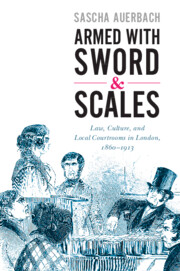Book contents
- Armed with Swords & Scales
- Studies in Legal History
- Armed with Swords & Scales
- Copyright page
- Dedication
- Epigraph
- Contents
- Figures
- Acknowledgments
- Glossary of Terms and Abbreviations
- Introduction
- 1 “Many-Coloured Scenes of Life”
- 2 “A Ruffian Rightly Punished”
- 3 “An Evil Quarter of an Hour about the Precincts”
- 4 “Two Shillings’ Worth of Revenge in the Form of a Summons”
- 5 A Poor Woman’s Court of Justice, 1882–1910
- 6 “The Very Centre of Observation and Information”
- Conclusion
- Bibliography
- Printed Primary Sources
- Secondary Sources
- Index
1 - “Many-Coloured Scenes of Life”
The Police Courts in Metropolitan Culture and Society, 1758–1860
Published online by Cambridge University Press: 05 February 2021
- Armed with Swords & Scales
- Studies in Legal History
- Armed with Swords & Scales
- Copyright page
- Dedication
- Epigraph
- Contents
- Figures
- Acknowledgments
- Glossary of Terms and Abbreviations
- Introduction
- 1 “Many-Coloured Scenes of Life”
- 2 “A Ruffian Rightly Punished”
- 3 “An Evil Quarter of an Hour about the Precincts”
- 4 “Two Shillings’ Worth of Revenge in the Form of a Summons”
- 5 A Poor Woman’s Court of Justice, 1882–1910
- 6 “The Very Centre of Observation and Information”
- Conclusion
- Bibliography
- Printed Primary Sources
- Secondary Sources
- Index
Summary
The first chapter traces the origins of the London police courts and the introduction of courtroom scenes as a literary and journalistic subject in the later eighteenth century. In the absence of an official police force, an orderly, hierarchical courtroom was necessary to sustain magistrates’ public legitimacy and to justify the considerable expansion of the summary court system. In the reformation of summary justice amidst its widening public portrayals, the courtroom’s legal capacity to punish disorder became indelibly linked to its cultural capacity to define public order and the putative threats to it. The first generation of courtroom reporters and the magistrates working in the early decades of the nineteenth century employed the locale to propose distinct visions of moral and social order in the metropolis. They set many of the precedents that would continue to define the courts and their public portrayals in subsequent decades.
Keywords
- Type
- Chapter
- Information
- Armed with Sword and ScalesLaw, Culture, and Local Courtrooms in London, 1860–1913, pp. 47 - 108Publisher: Cambridge University PressPrint publication year: 2021

